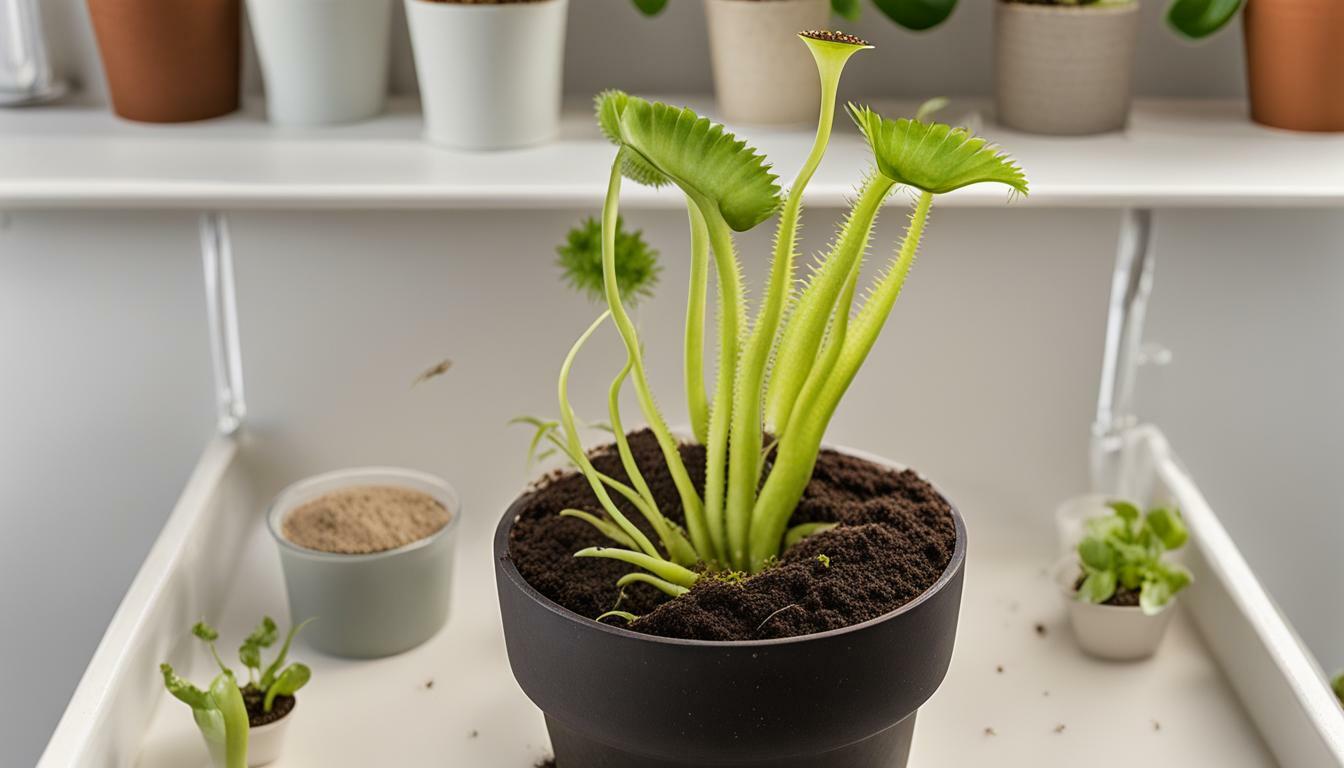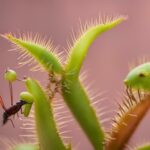Have you ever wondered if you can grow Venus flytraps from cuttings? The answer is yes, you can! Venus flytraps are fascinating plants that have captured the attention of many plant lovers and scientists for their carnivorous nature. Growing them from cuttings is a viable option, and in this article, we will guide you through the process.
Key Takeaways:
- Venus flytraps can be grown from cuttings
- Propagating Venus flytraps is a viable option
- Successful propagation requires proper care and maintenance
Venus Flytrap Propagation Methods: Exploring the Options
If you’re interested in growing your own Venus flytraps, you might be wondering what propagation methods are available. Propagation is simply the process of growing new plants from existing ones, and there are several ways to do this with Venus flytraps.
The most common propagation methods for Venus flytraps include:
- Leaf Pullings
- Flower Stalk Cuttings
- Root Cuttings
- Offsets
- Crown Division
- Cuttings
Out of all the methods, cuttings are a popular choice. The good news is that Venus flytraps can be grown from cuttings, and it’s a relatively simple process.
When using cuttings to propagate Venus flytraps, it’s important to choose healthy leaves. You can take cuttings from the leaves of mature plants during the growing season, which is typically in the spring and summer.
Once you have your cuttings, the process involves planting them in a suitable soil mix, keeping them moist, and providing them with the right amount of light and warmth. In a few weeks, you should see new growth emerging from the cuttings.
While cuttings are a great option for propagating Venus flytraps, they aren’t the only one. Each method has its own benefits and challenges. For example, leaf pullings are a great choice for beginners, while offset division is best suited for mature plants.
It’s important to weigh the pros and cons of each method before deciding which one is right for you. Depending on your skill level and the resources available to you, one method might be more suitable than the others.
Venus Flytrap Propagation Methods: Exploring the Options
To summarize, there are several methods for propagating Venus flytraps, and cuttings are a popular choice. While each method has its own benefits and challenges, cuttings can be a great option for beginners and skilled growers alike. By following the right steps and providing the right care, you can successfully propagate Venus flytraps from cuttings and enjoy these fascinating carnivorous plants in your own home.
How to Propagate Venus Flytraps from Cuttings
If you’re looking to grow Venus flytraps from cuttings, it’s important to understand the process and approach it with care. Follow these steps for successful propagation:
- Select your cutting: Choose a healthy leaf with a long petiole. Avoid selecting leaves with brown or black spots, as these may indicate disease or damage.
- Prepare your equipment: Have your cutting tool, rooting hormone, and pots with well-draining soil ready. You can use a mix of peat moss, sand, and perlite to create an ideal growing environment.
- Cut the petiole: Use a sterile cutting tool to make a clean cut at the base of the petiole, just below the soil line. Be careful not to damage the leaf blade during the cutting process.
- Apply rooting hormone: Dip the cut end of the petiole into rooting hormone powder, coating it evenly. This will stimulate root growth and increase the chances of successful propagation.
- Plant the cutting: Insert the petiole into the soil mix, taking care to bury it deep enough for stability but not so deep that it covers the leaf blade. Water thoroughly.
- Provide ideal growing conditions: Place the pot in a bright area with plenty of indirect sunlight. Keep the soil moist but not waterlogged, and maintain a high level of humidity to promote growth.
It’s important to be patient during the propagation process, as it can take several weeks for roots to establish and new growth to appear. You can cover the pot with a plastic bag or a clear plastic container to increase humidity and promote faster growth.
Venus Flytrap Cuttings: Essential Care Tips
Now that you’ve successfully propagated your Venus flytrap cuttings, it’s important to provide proper care to ensure healthy growth. Here are some essential care tips:
1. Light
Venus flytraps require a lot of sunlight to thrive. Place your newly propagated cuttings in a sunny area, such as a south-facing window. If you are growing them outdoors, make sure they receive at least 6 hours of direct sunlight per day.
2. Water
Water your Venus flytraps with distilled or rainwater. Avoid using tap water, as the minerals can harm the plant. Keep the soil moist, but not waterlogged. You can water your cuttings by placing them in a tray of water for a few minutes, then removing them and allowing the excess water to drain.
3. Soil
Venus flytraps require a well-draining soil mixture. Use a mixture of 50% peat moss and 50% perlite or sand. Avoid using regular potting soil, as it may retain too much moisture.
4. Temperature
Venus flytraps prefer cooler temperatures, between 70-85°F during the day and 50-60°F at night. Avoid placing them in extremely hot or cold areas, such as near air conditioning or heating vents.
By following these essential care tips, you’ll ensure that your Venus flytrap cuttings continue to thrive and grow into healthy adult plants. With a little patience and care, you can enjoy the unique beauty and fascinating capabilities of these carnivorous wonders right in your own home or garden.
Potential Challenges in Growing Venus Flytraps from Cuttings
While growing Venus flytraps from cuttings is a viable method of propagation, there are some challenges to be aware of. Here are some potential obstacles you may encounter:
- Disease and pests: Like any plant, Venus flytraps are susceptible to disease and pests such as spider mites and aphids. Be sure to keep a close eye on your plants and take action immediately if you notice any signs of trouble.
- Transplant shock: When you transplant your Venus flytrap cuttings into their permanent containers, they may experience some shock as they adjust to their new environment. This can manifest as wilting or yellowing leaves. Be patient and provide extra care during this period.
- Environmental factors: Venus flytraps have specific environmental requirements, such as high humidity and acidic soil. If these conditions are not met, your cuttings may struggle to grow and thrive.
Despite these challenges, with proper care and attention, you can successfully propagate Venus flytraps from cuttings. If you encounter any issues, don’t be discouraged! Experiment with different methods and techniques until you find what works best for you and your plants.
Tips for Successful Venus Flytrap Propagation
Propagating Venus flytraps from cuttings requires careful attention and patience. Here are some additional tips to help ensure success:
- Timing: The best time to take cuttings is during the plant’s active growing season, which typically begins in the spring and lasts through the summer. Avoid taking cuttings during the plant’s dormant period in the fall and winter.
- Plant Selection: Choose healthy, mature plants with strong stems and vibrant leaves for optimal success. Avoid taking cuttings from weak or sickly plants.
- Cutting Preparation: Use a clean, sharp pair of scissors or pruning shears to take cuttings that are approximately 3-4 inches long. Be sure to cut just below a leaf node, and remove any flowers or buds from the cutting.
- Preparing the Medium: Use a well-draining soil mix, such as a 50/50 blend of peat moss and perlite. Moisten the soil slightly before planting the cutting.
- Planting: Insert the cutting into the soil mix, up to just below the surface. Gently press the soil down around the cutting to ensure it is secure and in good contact with the soil. Mist the cutting with water to provide additional moisture.
- Environment: Keep the cutting in a warm, humid environment with bright, indirect sunlight. Covering the cutting with a plastic dome or bag can help maintain moisture and humidity. Avoid direct sunlight and extreme temperature fluctuations.
- Patience: It can take up to several weeks for the cutting to form roots and begin to produce new growth. Resist the temptation to check or disturb the cutting too frequently. Be patient and let nature take its course.
By following these tips and the step-by-step instructions provided in this article, you can successfully propagate Venus flytraps from cuttings and enjoy the beauty of these fascinating carnivorous plants in your home or garden.
Conclusion
Propagating Venus flytraps from cuttings is a viable and rewarding option for carnivorous plant enthusiasts. Through this process, you can create new plants that are genetically identical to the original and maintain the unique characteristics that make these plants so captivating.
By following the step-by-step instructions outlined in this article and providing proper care and maintenance, your cuttings can thrive and produce healthy, happy Venus flytraps.
While there may be challenges along the way, such as fungal infections or improper watering, with patience and diligence, you can overcome these hurdles and enjoy the beauty and intrigue of Venus flytraps in your own home.
So, don’t hesitate to give Venus flytrap propagation a try. With the right tools, knowledge, and care, you can successfully grow these fascinating plants and add a touch of natural wonder to your indoor garden.
What Are the Benefits of Growing Venus Flytraps Hydroponically?
Venus flytrap hydroponic cultivation guide offers numerous benefits. Growing these carnivorous plants hydroponically allows for precise nutrient control, ensuring optimal growth and health. It eliminates the need for soil and reduces the risks of pests and diseases. This method also provides greater flexibility in growing conditions, making it easier to replicate their natural habitat.
FAQ
Q: Can Venus flytraps be grown from cuttings?
A: Yes, Venus flytraps can be grown from cuttings. It is one of the methods used for propagating these carnivorous plants.
Q: What are some methods for propagating Venus flytraps?
A: There are several methods for propagating Venus flytraps, including leaf pulling, root division, and using cuttings.
Q: How can I propagate Venus flytraps from cuttings?
A: To propagate Venus flytraps from cuttings, you will need to carefully remove a healthy leaf with a petiole, plant it in a suitable growing medium, and provide the proper care and conditions for rooting.
Q: What care tips should I follow for Venus flytrap cuttings?
A: Venus flytrap cuttings require proper lighting, regular watering with distilled or rainwater, well-draining soil, and a cool environment to thrive.
Q: What are some potential challenges in growing Venus flytraps from cuttings?
A: Some challenges you may face when growing Venus flytraps from cuttings include rotting, fungal infections, and transplant shock. However, with proper care and attention, these challenges can be overcome.
Q: Any tips for successful Venus flytrap propagation?
A: Timing is important when propagating Venus flytraps, as well as selecting healthy parent plants. Additionally, maintaining consistent humidity and avoiding excessive handling of the cuttings can increase your chances of success.










